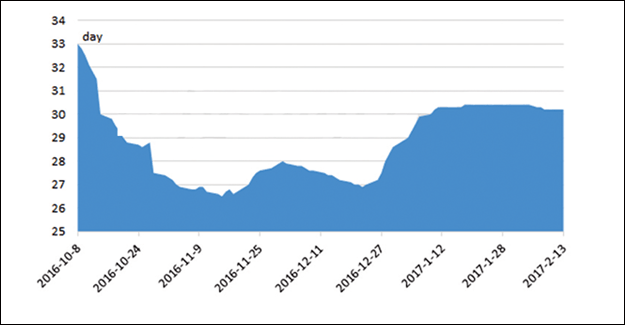Cotton Demand Is Dull In China As Industry Waits For Reserve Auction
Cotton Demand Is Dull In China As Industry Waits For Reserve Auction

In the first week after the Chinese Lunar New Year, ginning factories, traders and textile mills resumed work gradually and cotton prices are revised up by 200-300 yuan per metric tonne, but actual transactions are scarce overall.
Operating status
Textile mills generally resumed operation during Feb 2-6 and traders mainly started work from Feb 4. For ginning factories, most of them tended to restart after Lantern Festival (Feb 11) as the ginning of seed cotton was basically finished before the holiday. So currently, market offers are mainly from traders.
Status quo after the holiday
ICE cotton futures market rose during the holiday and sellers held positive anticipation towards the market after the holiday, so offers of cotton were revised up 200-300 yuan/mt and imported cotton prices in bonded areas moved up by 2-3 cent/lb.
Chinese cotton prices ticked up followed by higher Zhengzhou cotton futures, but the increment of cotton with different grades differed. The increment of long staple cotton was smaller, while offers of upland cotton rose by 200-300yuan/mt, and trading prices were up about 100yuan/mt. Currently, buyers were active to enquire, but actual transactions were limited.
Imported cotton prices also stepped up after the holiday, but the growth was slightly lower compared to Chinese cotton. After the holiday, the major sources in bonded areas were US, Indian and Australian cotton and prices were up 2-3 cent/lb generally. The mainstream offers of US cotton were in the range of 88-89 cent/lb, some highly to 90 cent/lb, and Australian cotton was offered at 92-93 cent/lb, up to 94 cent/lb with better quality. Cleared foreign cotton prices witnessed larger increment. Trading prices of Australian cotton, Good Middling, were above 18,000 yuan/mt and Indian cotton at 16,200 yuan/mt. Trading volumes of Australian cotton were better than that of Indian and US cotton by virtue of its quality and transactions were seen successively in the first week after the holiday.
Despite of allocation of cotton quotas before the holiday, many traders and mills have not received enough quotas yet. Meanwhile, with the arrivals of imported cotton in February and March, demand for quotas also increased, driving up the cotton quotas prices after the holiday, up to 2,000 yuan/mt. In 2017, mills were to restart operation earlier compared to previous years, but transactions recovered slowly. The recovery of downstream demand needs to be observed and trading sentiment is expected to improve after Lantern Festival.
Large inquiries, but scarce transactions
By February 10, cotton stocks in textile mills were averaged at 30.2 days. Secondly, offers were too high, and transactions were scarce. Driven by higher cotton futures, traders revised up offers, but due to high commercial stocks and limited demand from downstream sector, offers were beyond market anticipation. Thirdly, mills are waiting for the start of state cotton auction. With adequate cotton stocks at hand, mills mainly purchased on need-to-basis, waiting for the state cotton auction.
Fourthly, though mills and weavers resumed operation mostly, the operating rate was not high. Buyers mainly held looking-on stance and considered to procure cotton after Lantern Festival.
Market outlook
Buyers are not anxious to procure cotton at present due to adequate cotton stocks, high offers and coming state cotton auction. For Zhengzhou cotton futures, the market is expected to be range-bound above 16,000 yuan/mt shortly.
Transactions are predicted to improve slightly as mills return from the holiday, but the trading volumes are likely to remain limited.



 textileexcellence
textileexcellence 







